The Facts
Club History
WHAT IS THE OMAHA BEE CLUB
The Omaha Bee Club is a 501c3 educational beekeeping association. We try to help honey bees maintain healthy, living populations in the Omaha/Metro area. In order to accomplish this, we provide a number of support, resources and services to area beekeepers who then use those resources to keep their bees in healthy, populous conditions.
As a 501c3 educational association, donations and contributions to the Omaha Bee Club are tax deductible and are a very good way for supporters of bees and the local environment to invest in our shared ecological community.
OUR BEGINNING
The Omaha Bee Club’s Mission is “To enable successful beekeeping in the Omaha metro area by providing education, training, fellowship, and mentorship throughout the year and across all levels of beekeeper development. The Omaha Bee Club partners with aligned organizations to improve the environment and diversify and improve honeybee habitat”.
A little history about the Omaha Bee Club. The club started with about 4 members in June of 2010. One of the members had a conservation bee yard at the Fontenelle Forest for the purpose of allowing rescued bees a place to re-establish and recover from the stress relocation puts on a colony. After a few more people expressed interest in learning beekeeping, the Omaha Bee Club was founded.
At the time, the meetings were held at the conservation bee yard in Fontenelle, the group took on the name of “Fontenelle Bee Club” in honor of the place it got its start. Since then, the Bee Club changed its name to Omaha Bee Club to avoid confusion with Fontenelle Forest.
Since that June in 2010, the Bee Club has grown incredibly with over 385 members, has expanded to consistent monthly meetings at the Nebraska Extension Office, hosts open apiary session at our club's apiary, offers workshops on various topics and offers an annual fall bee convention for Midwest beekeepers.
Honey Bee Facts
Did You Know?
About the Honey Bee
Approximately one third of all the food Americans eat is directly or indirectly derived from honey bee pollination. Some crops pollinated are cucumbers, almonds, carrot seed, melons, apricots, cherries, pears, apples, prunes, plums, pluots, seed alfalfa, cantaloupe, seed onions, avocados, kiwi, blueberries, cranberries, etc.
There are three members of a honey bee colony:
Queen - mother to all the bees in the colony; she is a fertile female.
Worker - an infertile female that performs the labor tasks of the colony, including feed preparation, guarding the hive, feeding the queens, drones and brood, and heating and cooling the hive.
Drone - the male that starts out as an unfertilized egg. Its only purpose in the colony is to mate with a virgin queen. They live to mate with the queen, but not more than one in a thousand get the opportunity to mate.
On average, a worker bee in the summer lasts six to eight weeks. Their most common cause of death is wearing their wings out. During that six to eight-week period, their average honey production is 1/12 of a teaspoon. In that short lifetime, they fly the equivalent of 1 1/2 times the circumference of the earth.
The peak population of a colony of honeybees is usually at mid-summer (after spring buildup) and results in 60,000 to 80,000 bees per colony. A good, prolific queen can lay up to 3,000 eggs per day.
Drones fly on United Airlines. This is a corny joke amongst beekeepers because of the way queens and drones mate. When a queen is five to six days old, she is ready to mate. She puts out a pheromone scent to attract the males and takes off in the air. The males from miles around smell the scent and instantly volunteer in the mating chase, which is performed in the air.
Basic Beekeeping
Basic beekeeping simplified is having:
New, viable queens
Feed (natural or artificial)
Good, sound equipment
Disease-free hives (good medication program or integrated pest management)
When processing honey from a beehive, a good rule of thumb is for every 60 pounds of honey produced one (1) pound of beeswax will be made (1 to 60 ratio).
In order to manipulate population dynamics, the timing of hive management is critical, such as the splitting of hives just prior to swarming season. Also, feeding syrup and pollen supplement at least 21 days prior to a pollination inspection or honey flow induces the queen to lay eggs.
information provided courtesy of ABF member Lance Sundberg
